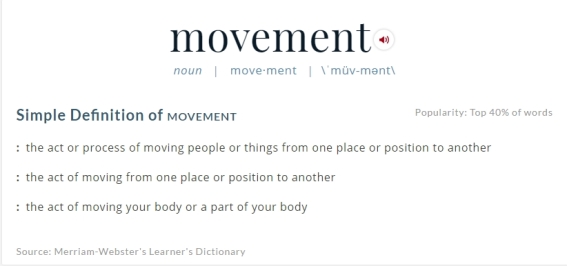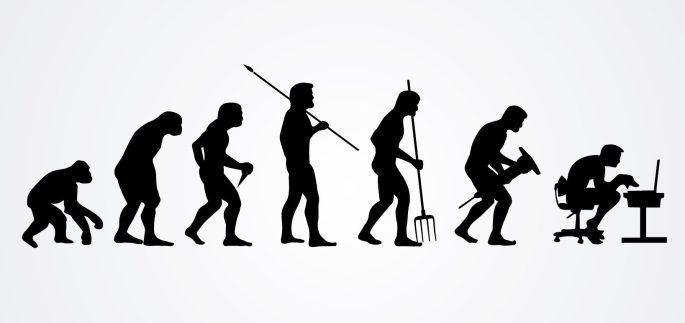Over the last few years, one word has become super “hip” within the field of health and fitness: movement. It is a word that has always been around, but that has now become the symbol of a new paradigm.
Let us look at what the dictionary has to say about movement:

Hmm, pretty basic, right?
So, why the fuzz about movement? Why should we move more? And why does this not simply mean to do more exercise? Is movement just a new fad? Is the trend towards movement good? And what does it all mean for the simple man or woman who is interested in a healthy life, or simply in caring for their body? These are questions we want to begin to explore hereafter.
Maybe it helps to start by reflecting on the evolutionary nature of our human bodies. For most of history, humans simply had to move much more and in a much more varied way than many of us do today. Think about it, many of the standard commodities of the modern world didn’t exist even a hundred years ago. Cars and trains, running water, heating and elevators, just to name a few. For most of human history, people did not use chairs to rest while today, many of us sit in chairs (and on couches) more than ten hours every day. As hunters and gatherers, we had to move in a variety of ways and at different intensities on a daily basis, walking (a lot), running, balancing, lifting and carrying objects, jumping, throwing and catching things, climbing and even crawling. Our bodies today are still a result of these demands. And even after farming had been invented, most people would move many hours a day working, squatting, carrying and lifting. Modernity, however, has brought other kinds of demands and has reduced our movement variety by a large degree. If we do not engage in athletic endeavors, many jobs and the common household tasks do not require much more movement than to sit on and get up from chairs and couches, walk a couple of hundred meters and use our hands and upper bodies for light tasks like typing on a computer, carrying documents and bags as well as the occasional forward bend to pick something up or sweep our floors. This mismatch between the evolutionary nature of our bodies and life in modern day society has been very interestingly described in the popular book “The Story of the Human Body”, written by Harvard professor Daniel E. Lieberman.

The fact that our bodies are still craving natural movement patterns even though we do not need them anymore to survive in the modern world, also stands behind MovNat, a physical education and fitness system that aims at developing physical competence through learning a variety of natural and applicable movement skills through mindful and technical practice. This kind of practice does not only increase our level of overall activity, but also teaches us movement skills that are practical and applicable in the real world. This way we are not only giving our bodies what they crave (many forms of natural movement), but also learn how to do our everyday tasks more efficiently while at the same time increasing our strength, endurance and mobility.
Having opened up the discussion with a somewhat evolutionary perspective on movement, I would now like to introduce Ido Portal, who is an inspiring athlete and one of the most prominent movement proponents, too. He has been advocating a “movement lifestyle” for a number of years now and has largely been responsible for the shift towards movement in the health and fitness field. Ido proposes to go beyond the sometimes narrow limits of separated movement disciplines and explore all the possibilities the human body has to offer with regard to movement. This can include patterns commonly used in disciplines as different and diverse as dance, gymnastics, parkour, strength training, sports, climbing, yoga and martial arts (Ido has a large background in the beautiful Brazilian martial art of Capoeira).
Ido Portal has termed words like “depmoved” which stands for “deprived of movement” and which according to him is true for most of our culture. For people to begin moving towards a movement lifestyle (pun intended!) he is known to recommend incorporating two basic human movement patterns into one’s daily life: hanging and squatting.
To add another important perspective, I’d also like to introduce Katy Bowman, a biomechanist from the United States that has published various books on the topic of correct alignment, foot health and movement. Her most famous book is called “Move your DNA” in which she describes how our “depmoved” modern lifestyle is inevitably leading to the widespread health problems we’re seeing around. She explains how the lack of regular natural movement patterns affects us negatively even on a cellular level, as almost all of the (trillions of) cells in our bodies have built-in mechanisms to sense our movement – or, our lack thereof. She describes exercise as just a small part within the huge field of human movement. To have a varied and healthy “movement diet”, it is therefore not enough to counter the 8+ hours of sitting every day with just one hour of exercise (which often only consists of one or two movement patterns).
As Katy Bowman explains in the video, it is an integral part of health and well-being to have a varied and healthy movement diet, which means learning about movement quality and engage in a variety of natural movement patterns on a regular basis.
In short: care for the body = lots of nutritious movement.
Or as Ido Portal puts it: use it or lose it – move or die.
PS: If you’re wondering where to start, follow the links in the article above that explain how to incorporate hanging and squatting into your daily life, or have a look at the YouTube channels of MovNat and Katy Bowman to get some movement inspirations!
Images:
* http://www.merriam-webster.com/dictionary/movement
** https://www.vectoropenstock.com/vectors/preview/71108/evolution-of-human-work-silhouettes
